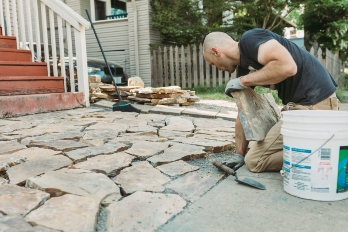Thinking about buying a home? Who better to turn to for advice than actual homeowners. Bank of America asked more than 1,200 homeowners what advice they would share with aspiring homebuyers, and here are the five tips that rose to the top:
- Start saving for your home early
- Consider maintenance costs and unexpected expenses
- Create and stick to a budget
- Buy a home sooner to start building equity
- Buy a home you can grow into, that fits future needs and goals
Sounds good. Even obvious, right? But of course some of this stuff is easier said than done. What do these tips look like in practice, in real life? To flesh them out, we asked members of our own team. There are plenty of new and long-time homeowners around Framework. What are their experiences in these areas? What have they done right? What mistakes have they made?
Take whatever ideas, motivation, and inspiration you can from these tips, successes, and cautionary tales.
1. Start saving for your home early
Saving for a down payment is hard these days. So, most of us need to start sooner rather than later. Yet with tight job prospects and student loan debt so often part of the equation, how do you do that? Laura lived with her parents.
The parent option isn’t always both possible and palatable. But for Laura, a content specialist at Framework, it was. And it helped her buy her own home, by herself, when she was still in her twenties.
About a third of all millennials still live with their parents, a number that’s ballooned in the last decade, according to the US Census Bureau. That’s about 24 million people between the ages of 18 and 34. Laura says that, for her, lack of job opportunities was part of it, but so was her goal of buying a home.
“When I returned to my hometown a few years after college,” she says, “I started living with my parents because I was making next to zero dollars working part-time jobs. But once I decided to become a homeowner, I continued living with my parents to save money. I paid them a modest rent and started saving everything else.”
After saving for three years — and finding full-time employment — Laura had enough for a 10% down payment on a two-bedroom townhome near St. Paul, MN. “That made my monthly payment more affordable, and I even had a few dollars left for new paint!”
2. Consider maintenance costs and surprise expenses
The surprise element is of course the hardest. As contradictory as it sounds, all homeowners need to plan for the unexpected. Or better yet, says Kelly, proactively dig for potential problems before they become surprises.
Consider Kelly’s %&@#! dryer vent.
“I thought it just needed to be cleaned out, but it had to be replaced, so we went from $80 to $500. Really, for that little thing,” says Kelly, a partnership associate at Framework. She recently bought a 1930s condo in the Greater Boston area.
“I think knowing ahead of time really does make a difference,” she says. “I knew going in that the furnace would need to be replaced, so I’m not so upset about that. Because I didn’t expect the dryer vent to be so much money, even though it’s thousands less than what the furnace will be, I was kind of like, What?!”
Now that she realizes how much the previous owner neglected basic maintenance, she wishes she pressed for more information from him during the sale, “maybe a checklist that would show the last time all these items were maintained or repaired.” That way, she could have prepared better both financially and mentally.
One way she’s been coping: Angie’s List* coupons. “Angie’s List somehow knows exactly what I need,” she says. “I’ve bought coupons for the dryer vent cleaning, HVAC and furnace maintenance, gutter cleaning, and waxing the floors.” Her Angie’s list experience has been so positive, she’s become a paying member.
3. Create and stick to a budget
Easier said than done, right? That was Prabin’s experience, until he and his wife had a baby and decided to buy a house outside Boston. The game-changer for them was Mint, the online financial management tool.
“I had always looked at my numbers in separate places,” says Prabin, Framework’s VP of operations and information systems. “I never had true visibility of all the expenses.”
“With Mint*, I have all the information pulled into a central location, and I can see all the cash coming in and all the cash going out,” he says. “The system is smart enough to divide up the categories. So, if I want to limit eating out to $200, the system will tell me if I’ve reached that.”
As part of thinking about how much house they could afford, Prabin used spreadsheets to look at the impact of different-size mortgages on their budget. “It gave me a solid understanding of how much cash would be left on a monthly basis. It was important to me not to sacrifice too much. I can cut down eating out, but not to zero.”
His one mistake, he says, was not accounting for larger utility bills, including the water and sewer bills they didn’t have as renters. It helps to ask the owner of the home you’re buying for their average costs. Be sure to find out how many people have been living in the house too, and do your best to adjust the figures up or down.
4. Buy a home sooner to start building equity
Buying a home can be a stretch at any age, but especially when you’re young. For Maria, a first-generation immigrant, stretching early on paid off a dozen years later with $100,000 in equity and a piece of the American Dream.
Twenty years ago, Maria and her husband had been out of college for only a year when they heard about a local revitalization program that was building affordable new single-family homes. They jumped on it. Equity wasn’t really part of their thinking at that point, says Maria, who’s now VP of product platforms at Framework. “For me, the big thing was I would be able to garden and paint the walls any color I wanted.”
They had to commit to living in the home for five years, but five years turned into twelve as they realized how much equity they were starting to build, Maria says. A rising market in their Rhode Island city helped, but they also did a lot of work on the house: over the years, they turned the little Cape’s original dirt lot into a real yard and added two bedrooms and another bathroom.
“Looking back, it was very stressful because I did not think we had enough money,” she says. “It felt like a sacrifice, but it was a manageable sacrifice. And because we were willing to take the leap and make those sacrifices early, it gave us a lot of freedom later.”
Meaning that they eventually used that equity to buy land and build something closer to their dream house in a less urban location. “All because of equity, when we had children, I could give them their own bedrooms,” Maria says. “We have deer and turkey and other wildlife in the backyard. I feel like I don’t need to move again. I feel like this is my home home.”
5. Buy a home you can grow into, that fits future needs and goals
This often means “plan for kids.” Family-minded Leah and her husband had their hearts set on a three-bedroom single-family house. And that required extra “scenario planning.”
“We had one kid but knew we wanted a second,” says Leah, who works at one of Framework’s nonprofit owner organizations. “So we wanted at least three bedrooms. And a backyard for them to play in.”
A community they could grow into was important too, she says. The Boston-area city they bought in has good public schools and plenty of parks and kid-centered activities.
But could they afford it in the long term? “Our childcare payment for an infant was almost as much as our mortgage,” Leah says. “How would we pay our mortgage with two kids in day care?”
“We did scenario planning, basically,” she says. “I have friends in hot markets who have gone through the same thing. So I went out and asked people, How do you afford your house and have two kids?”
The solution: save in advance for that double-daycare period, building it right into the budget. They calculated the maximum mortgage payment they could handle while meeting their savings goal. “If we hadn’t planned that,” Leah says, “I think we would have had a hard time making everything fit together.”
* Framework is not affiliated with Angie’s List or Mint.




